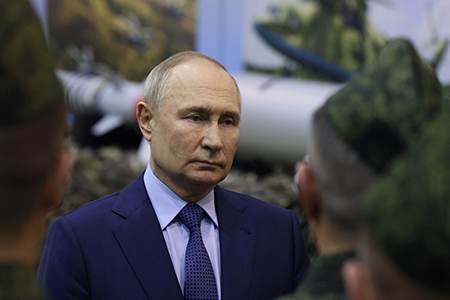Russia Proposes One-Year New START Extension
October 2025
By Xiaodon Liang
Russia is “prepared to continue observing the … central quantitative restrictions” of the 2010 New Strategic Arms Reduction Treaty (New START) for one year after its expiration if the United States “acts in a similar spirit,” Russian President Vladimir Putin announced at a Sept. 22 Russian Security Council meeting.

New START, which limits U.S. and Russian nuclear forces to 1,550 strategic warheads and 700 strategic launchers deployed on each side, will expire Feb. 5, 2026. In 2021, the United States and Russia agreed to exercise a clause of the treaty permitting a one-time, five-year extension.
Speaking at a Sept. 22 news conference, White House Press Secretary Karoline Leavitt said the proposal sounded “pretty good.” Two weeks later, President Donald Trump, answering a question from a TASS reporter, affirmed the U.S. view, saying of Putin’s proposal, “it sounds like a good idea to me.”
U.S. Secretary of State Marco Rubio met with Russian Foreign Minister Sergey Lavrov Sept. 24 in New York on the sidelines of the United Nations General Assembly meeting. Although the two sides “compared their positions on the entire bilateral agenda,” according to the Russian statement summarizing the meeting, no progress was announced on arms control.
In extending the Sept. 22 offer, Putin said “a complete renunciation of New START’s legacy would, from many points, be a grave and short-sighted mistake” with “adverse implications for the objectives of the [nuclear Nonproliferation Treaty].”
Following the proposed one-year extension, Russia would make “a careful assessment of the situation [and] a definite decision on whether to uphold these voluntary self-limitations,” Putin said.
In his remarks, Putin did not say that an agreement, explicit or tacit—or even a U.S. announcement—was required before Russia would adopt its unilateral freeze. The measure would not be viable, however, if the United States takes “steps that would undermine or disrupt the existing balance of deterrence,” Putin said.
The Russian leader specifically named U.S. “preparations for the deployment of [missile defense] interceptors in outer space” as a step that could destabilize the strategic balance. (See ACT, September 2025.) Russia previously stated its concerns about the Trump administration’s plans for a comprehensive missile defense system, known as Golden Dome, in a May 8 joint statement with China. (See ACT, June 2025.)
A Chinese foreign ministry spokesman said Sept. 23 that his country “commends the positive stance” taken by Putin, before reiterating China’s standard rejection of Trump’s call for Beijing to take part in arms control negotiations alongside Moscow and Washington before the latter two make further substantial reductions in their arsenals.
Although Trump has not responded in public to the Russian proposal, he once again aired his skepticism of nuclear weapons in a Sept. 23 speech before the UN General Assembly.
“We want to have a cessation of the development of nuclear weapons,” the president said, noting that U.S. nuclear weapons “are so powerful that we just can’t ever use them.”
“If we ever use them, the world might literally come to an end,” he said.
But Trump has also previously said arms control talks with Russia might come only after the termination of the Russian full-scale invasion of Ukraine. (See ACT, September 2025.)
In a rhetorical shift following a Sept. 23 meeting with Ukrainian President Volodymyr Zelenskyy on the sidelines of the General Assembly, Trump said in a social media post that he believed Ukraine could restore its pre-2014 borders.
Although the president stopped short of offering further direct U.S. support for the Ukrainian war effort, he said the United States “will continue to supply weapons to NATO for NATO to do what they want with them.”
Zelenskyy, in his meeting with Trump, requested that the United States provide Ukraine with Tomahawk cruise missiles, The Telegraph reported Sept. 26. The Ukrainian leader confirmed at a Sept. 27 press conference that Ukrainian military experts would visit the United States in the coming weeks to negotiate a package of arms sales, valued close to $90 billion, that would be part of a post-conflict peace settlement.
